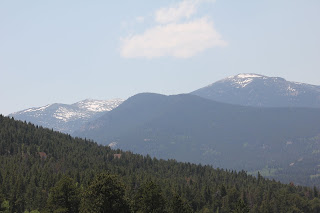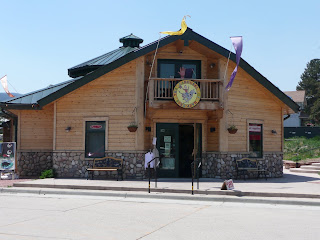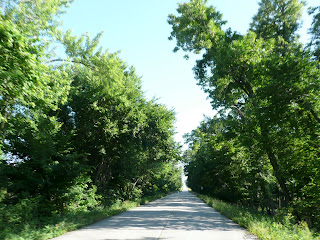Springfield, MO to Russell, KS
Day three took me from Springfield, Missouri to Russell, Kansas,
with sightseeing stops in West Mineral, Kansas and Hutchinson, Kansas. The day’s ride was not as ambitious as the
previous day, from a mileage perspective, but was quite long because of the
stops.
I left Springfield before 7:00 a.m., to beat the morning commuter
traffic. The temperatures were a brisk
46 degrees. After clearing Springfield, I
rode through some more beautiful farm land.
I soon discovered that the roads I was following was part of the famous
Route 66 route from Chicago to California.
After traveling approximately an hour and half from Springfield, I
turned onto some back country roads. The
roads alternated between fields and wooded areas where I found myself riding
through a tunnel of green.
My ride soon led me to the site of Big Brutus – the world’s
largest electric shovel. Even before I
arrived at the site, I was able to see the boom towering over the trees.
I soon arrived at the visitor’s center, which was still closed,
but opened shortly after my arrival. After
my admission fee, I chatting with a staff member for a few minutes, browsed the
museum’s indoor exhibits, and watched a video of original assembly footage of
Big Brutus. Then it was time to head
outside and see the real thing.
It was a short walk from the visitor’s center to the site where
Big Brutus now resides. For lack of a
better word, Bug Brutus is --- immense.
From the crawler tracks to the top of the boom, the shovel is 15 stories
tall. When the shovel was in operation,
it weighed about 11,000,000 pounds and was able to move 90 cubic yards (enough
to fill three railroad cars!).
The interior of the shovel is open for tours, but the boom is no
longer open to the public – the boom was closed in 2004 due to insurance
company concerns with liability. The
interior is huge.
The shovel operated for 11 years, around the clock, until ceasing
operation in 1974.
There were many other interesting antique machines on display
around the museum’s grounds.
After spending almost two hours there, I decided it was time to move
on to Hutchinson to see the Kansas Salt Museum.
The ride from West Mineral to Hutchinson was approximately 200 miles (about
three hours). The ride first took me
west on US Highway 400 to Wichita, then west and northwest to Hutchinson. By this time, the temperatures were climbing
into the mid 70s and the famous Kansas
winds were beginning to blow. Through
the remainder of the day, the winds were blowing a steady 25 to 30 mph, making
for a fatiguing ride.
The Kansas Salt Museum is part of a still operational salt mine and is the only salt mine
in the western hemisphere that is open for public tours.
After purchasing my ticket, I had to wait about one half hour for
the next tour to start. After watching a
short safety video, we were issued a hard hat and an emergency survival
breather kit, in case of a accident. If
needed, the breather kit would convert carbon monoxide into carbon dioxide. Mining regulations required that we have the
breather kits with us and that we wear hard hats will in the mine. The it was time to load the elevator for the
ride down 650 feet into the mine.
The ride down took and one and half minutes, and during the ride,
you could feel the pressure change occur in your ears. Once in the mine, we were told that the salt
vein in the area begins at a depth of 400 feet and extends to approximately 70 feet below us (remember,
we were at 650 feet). Above the salt was
a layer referred to as mud – basically shale rock.
After a short orientation talk, we were released for a self guided
tour through a gallery area. The gallery
had ceilings nine feet high, and extended hundreds of feet in front of us. We could see more of the museum area about
300 feet down the gallery.
Touring the galleries, you could see mock-ups of how salt mining
operations are conducted, the equipment used, and some of the old vehicles that
have been used in the mines over the decades.
One area included displays of a number of Hollywood film
props. Many Hollywood films and props
are stored in this mine because of the environmental conditions – a constant 68
degrees and 40 percent humidity.
A company has a 100 year lease for space in the mine for archival
storage facilities. They 218 galleries,
similar in size to the one we were touring, for storage of records, films, and
other things. Those areas are not open
to the public.
I also took both a tram ride and a train ride back into other
areas of the mine that show how it was left by miners over 60 years ago.
After more than two hours in the mine, I decided it was time to
head back to the surface. I still had
another two hours of travel to reach my final destination for the day –
Russell, Kansas. When I returned outside
the museum, the winds were still blowing as strong as earlier in the day, and
the winds made for a brutal and very tiring ride. I finally rolled into Russell a little after
7:00 p.m. It had been a long day, but
well worth it seeing both Big Brutus and the Salt Museum.































